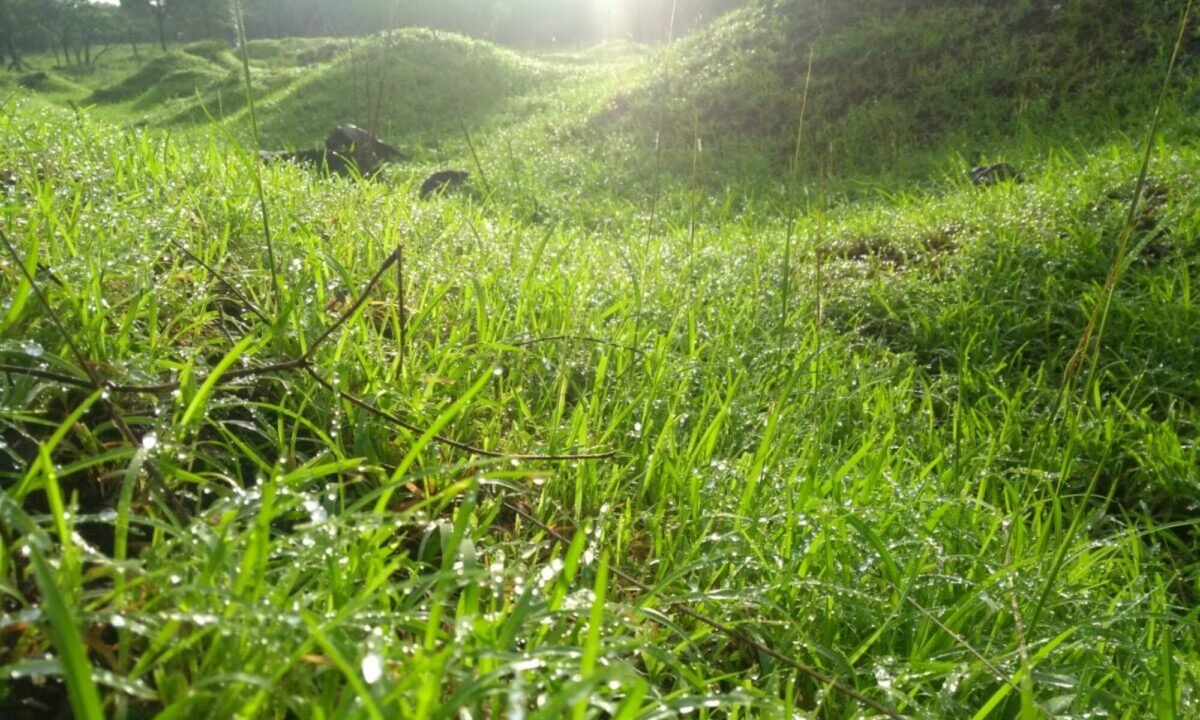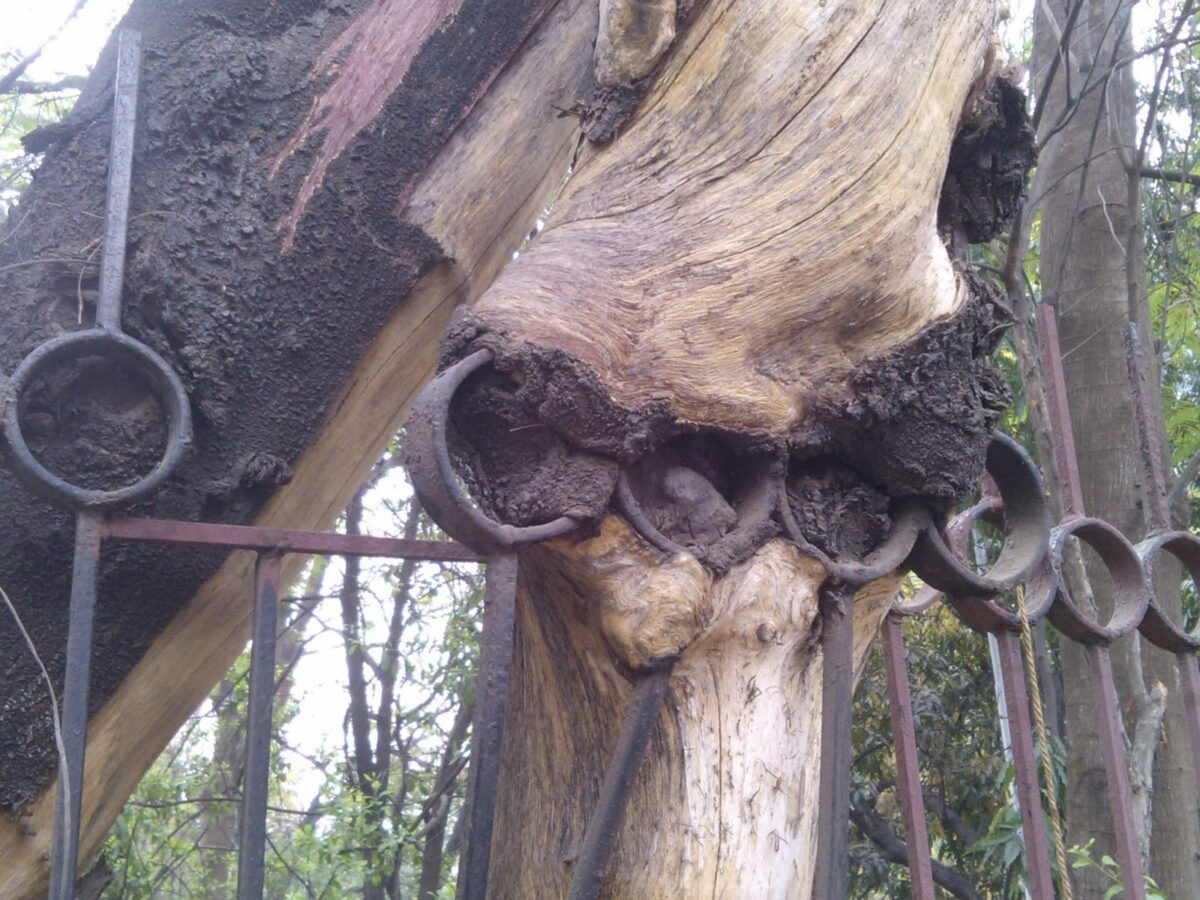
Tree Remains (Wordless Wednesday)
Potholed Wonders
I admit I too had not done much ‘sight seeing’ of significant places close to my city, or indeed in the city itself. Something that I have been consciously working to overcome over the last year or so. This post is about one such wonderful place that I visited recently.
Potholes usually evoke images of roads riddled with holes and pits with traffic mayhem all around. So when I read about possibly several hundred years old naturally formed potholes near Pune which are geological wonders themselves I just had to go there…
 |
| Natural potholes seen near Pune |
These are at a place called Nighoj about a couple of hours drive (approx 90kms) from Pune. The road is excellent except the last part when one has to lurch across the country roads to actually reach the river bed. We are going to see potholes remember?? Jokes apart, these are formations in the bed of the River Kukdi. The irregular jagged ‘holes’ or craters seem like a canyon and open up suddenly as one trudges along the hot rocky river bed. Despite seeing some amazing photographs in a magazine, the sight took my breath away.
These potholes are formed in the layered basalt rock of the river bed and extend for quite some distance and were about 25 feet wide and deep where we stood. The depth may be more in other parts according to reports. Being the peak of summer, the river had hardly any water, thanks also to the dam that is built on it. This showcased the full glory of the potholes and made them easily accessible as well.
 |
| Dam wall visible in the distance |
 |
| The holes are shaped like a pot being wider in the centre |
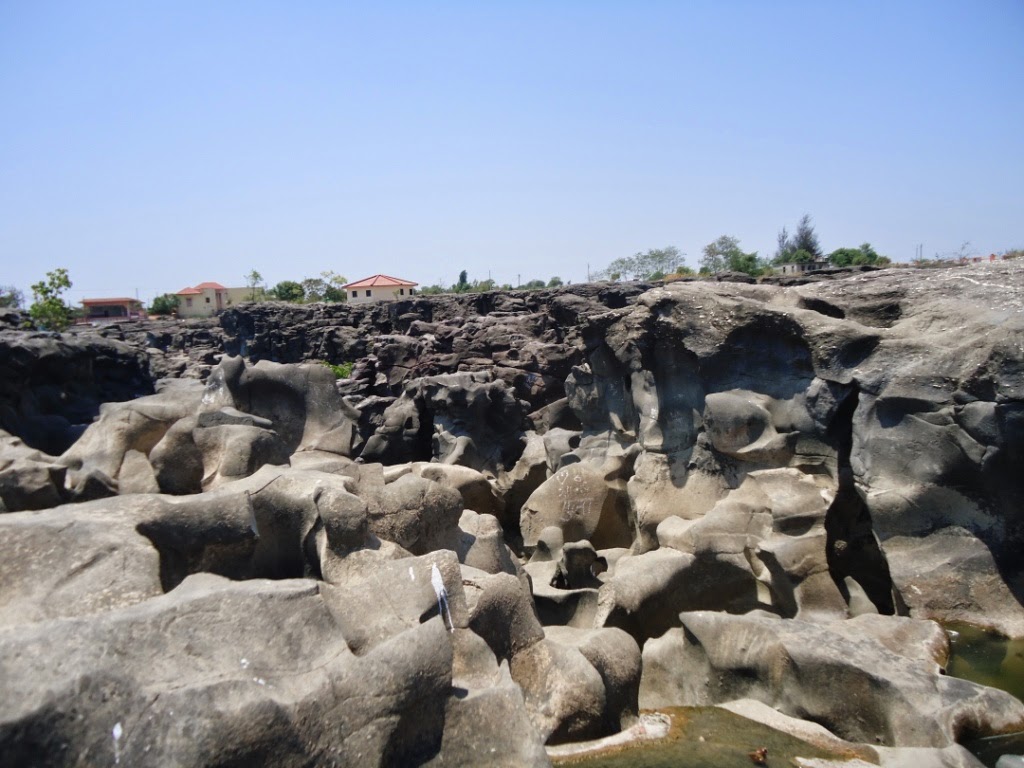
A huge plus was that the river bed was very clean. There were a couple of temples on both sides of the river and a Laman Jhoola built across it. One can see the potholes slowly end and the river bed gets the usual flat appearance downstream.
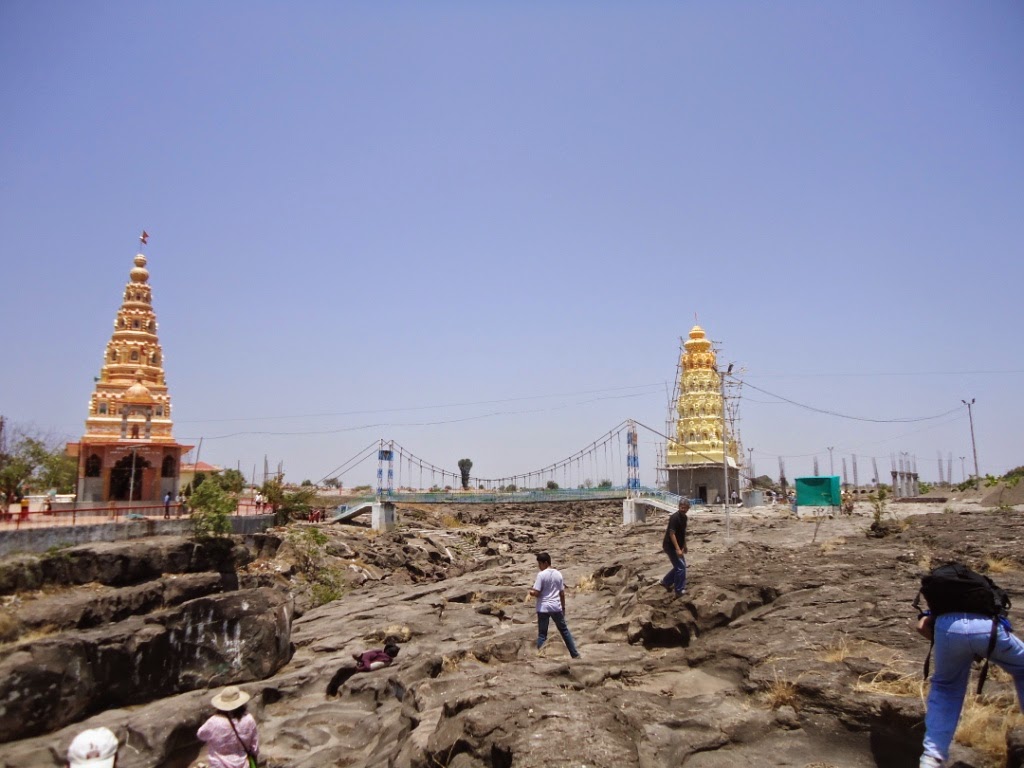 |
| Temples and Laxman Jhoola |
The area is home to the uncommon Capparis decidua. En route one passes several pomegranate fields as well as onion fields enroute where the harvested onions are stored in makeshift huts called ‘Kandyachee chaal’ कांद्याची चाळ (depending on the season you visit).
 |
| कांद्याची चाळ |
We were very lucky to see a colony of Swifts. It was a beautiful sight to see the birds feed their young ones. A binocular is a must!! Their nests are washed away every time the river fills up and they rebuild them again the next year. Tip: Keep utter silence so as the birds are not scared off.
 |
| Colony of Swifts |
If you are in Pune with half a day to spare do visit this amazing place.The famous Ranjangaon Mahaganapati Temple is located close by on the main Nagar Road and can be easily added to to the itinerary.
🙂
Happy travelling!
Health Benefits of Cycling (Worldless Wednesday)

This image is from the Times of India Pune edition dated 02 March 2014
http://epaper.timesofindia.
Disclaimer: All
suggestions are general in nature. Readers are advised to exercise
caution before implementing them and seek expert advise about what is
suitable for their specific needs.
Sacred groves (Nandivli)
Devrai is the marathi word for sacred groves, and loosely put, they can be described as forests that are protected by a local deity usually a Goddess (देवी) but some devrai have Khandoba or Mhasoba as their deity. The forest does not have a ‘temple’ in the form that we know it but it may be a simple structure made from local materials and the idol itself may be no more than a stone. Usually the offerings are flowers that have naturally fallen off trees and the blooms must not be deliberately plucked in a devrai. In fact nothing should be plucked in this forest or even taken away including dead or dry branches, twigs, leaves all of which must be left to decay there itself. The species growing in such protected forests thus get protection and thrive. Some shrubs, trees, roots etc may have medicinal properties. It is the ‘Bhagat’ who is the only person who is allowed to pluck such tree parts to help any sick villagers after offering due prayers to the tree. No one else can do so.
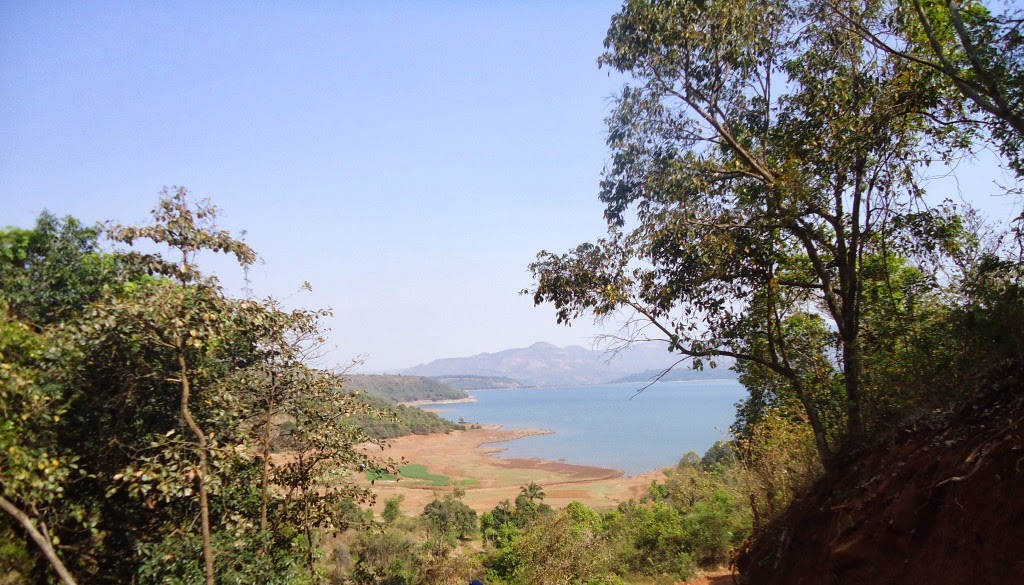 |
| Backwaters of the Mulshi Dam near Pune, Maharashtra |
The Sahyadris have about 3000 devrai and the Mulshi area has up to 30 sacred groves. The Kudawale devrai near Dapoli is said to be spread over about 100 acres. These can serve as reference ecosystems which will help chose the
correct species for any new plantation, afforestation projects in
the area. It takes a thousand years or more for a proper forest to develop and simply planting a few hundred trees is not akin to creating a forest.
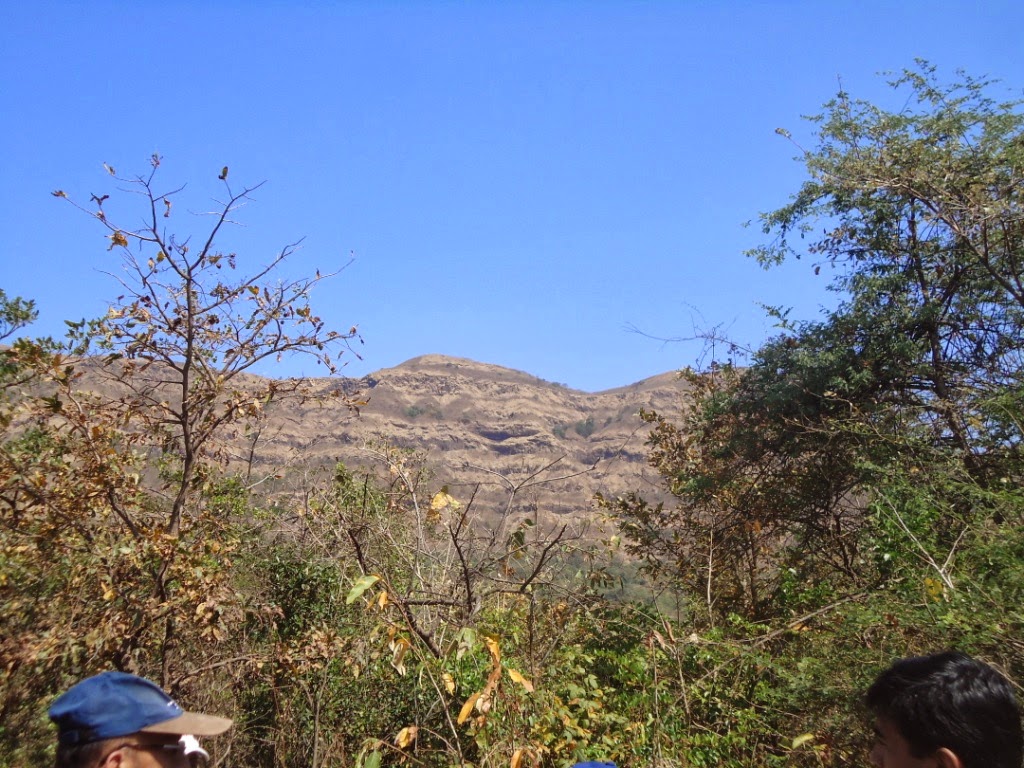 |
| The Sahyadri crest line near Mulshi Dam |
It is such blind faith has helped protect the forests from the relentless march of so-called progress and urbanisation that has extended cement and mortar monstrosities way outside Pune. The area of some devrai has reduced and some do not have undergrowth. The latter is an indication of regeneration of the species growing there. Lack of undergrowth heralds a bleak future for the devrai. Construction of new roads is a good thing but it may have a detrimental effect on such protected forests.
Here is a link to a Wikipedia article about devrai.
This article lists sacred groves in Maharashtra and here is one with some general information.
We recently visited a devrai near Mulshi. A tarred road to Lonavla ran through a part of this devrai. Access is by personal vehicles or an ST bus service from Pune (Swargate). As we neared Mulshi, the blazing red Dhaitee (Woodifordia fruiticosa) provided a welcome relief to the dry brown and yellow of the countryside as was the furry soft white inflorescence of the Bhamni. The weather had just started warming up and people were just about recovering from ‘Holi’. There was extensive flowering which was a pleasure and helped identification.
 |
| Bhamni: Cholebroochia oppositifolia |
We stepped out of the bus and were greeted by the sweet fragrance of the ‘Lokhandi’ (an Ixora species). You may remember the red walking sticks in Mahableshwar. They are made from this tree! Other trees specifically found in this grove were the Toran (Zizyphus rugosa). Its fruit is double the size of the usual Karwanda and is ready around the Divali festival. We were lucky to see blooming of the Waras (Heterophragma quadriloculare) , Vatoli (Diploclisia glaucescens), Shivan (Gmelina arborea), Kakad (Garuga pinnata) and Kuda. The Palas was in fruiting stage while the red blazing leaves of Baheda (Terminalia bellerica) and Kusumb gave a flaming touch to the scenery. I saw the Khedshingi with its strange looking fruit for the first time. The poisonous Hura (Sapium insigne) and Raan ghewda (Paracalyx scariosus) was a first for me as well.
My friends tell me that they could spot many varieties of birds and had an extremely satisfying bird spotting session here.
Here are some images (absolutely amateur variety!!) that I have taken during my visit to the devrai. Enjoy!
(Double click to open a new tab so the photo description can be seen)
Wordless Wednesday
Wordless Wednesday
Open Sesame!
prices but also because of Sankranti- a festival
celebrated across India albeit with different names in different states. So
whether it is Lori or Sankranti or Uttarayan or Bihu the vital ingredient of
the key preparations are Jaggery and Til (sesame).
by saying “तिळगुळ घ्या गोड बोला”
ice breaker and a good means to renew strained relationships. To facilitate
spreading bonhomie, the period from Sankranti day (usually 14 January) up to
Rathasaptami is considered auspicious for the same. Ladies are usually busy
with ‘Haldi Kumkums’ an occasion where each one can show-off her black saris. Usually a
no-no, black is a must, come Sankranti! Further we also have a tradition of
making jewellery out of halwa (balls made from sugar syrup and sesame seeds)
that is presented to a baby or at a bride’s first Sankranti.
stuffed with jaggery. To many the concept of sweet rotis is strange yet one
bite of this crisp poli lathered with ghee is sure to remove all doubts. Now
don’t frown at the ghee, its essential; Sankranti is not the time to count
calories.
married. My ever-dependable guide to home style Marathi food is a book called
‘Ruchira’ written by Kamalabai Ogale. I mustered up courage and decided to make
these polis that are considered to be the mark of a chef. I roasted the besan
in oil, roasted and ground poppy seeds and added them to grated jaggery to make
the stuffing. With the firmly mixed dough I was ready to begin. It seemed
simple enough – roll two small circles of the dough, put a bit of stuffing on
one, cover with other circle, roll out, cut off edges and roast on medium
griddle.
in the glory as my husband polished it off giving me the ultimate compliment-
that it tasted just like his Mom’s.
ahead of me quite sure it would be a breeze. Alas, the celebrations had come
too early. The second one on the pan suddenly seemed to come alive as its
surface erupted into umpteen bubbles spewing steam and hot jaggery droplets. I
got the melting mass off the griddle and began afresh.
got the process right and the last couple of polis were respectable again and
without the charcoal flavour that characterised most earlier attempts.
making Gul Polis. It’s now just a collection of pages – the binding having long
given up. I have not invested in a newer edition preferring to stand by this
proven model.
Maharashtra in this period that is used specifically to make laddoos. The catch
in making these laddoos is to get the jaggery syrup to the correct consistency
else the final product ends up becoming rock hard. Trust me; my dental architecture
has suffered from its effects. Further they have to be rolled when the mixture
is hot but greasing your palms with oil or ghee will keep them from burning.
is tooth friendly! It goes like this: roast and grind equal quantities of
groundnuts and sesame (white or polished variety). Grate good quality jaggery
(same quantity as other ingredients). Take little of groundnut powder, sesame
seed powder and jaggery and grind together in a mixer. Ideally it should be
pounded in a mortar and pestle (preferably an iron one). Add cardamom powder
and ghee as required to the entire ground lot. Roll into balls.
Sankranti with its rich repertoire of sesame dishes opens the door to lasting
good health and peace for all of us!
Ticket Trauma
Sawai Gandharva
Bhimsen Mahotsava is a much awaited, annual musical
festival in Pune. It’s prestigious for the artists performing there but from my
experience getting tickets for the ‘chair’ can be something of a prestige as
well. Not for the money, no… The ‘sofa’ seats are priced much higher.
procuring the tickets. For some reason, tickets are only sold at a few select
outlets in Pune, and as of 2013 there is no online option for ticket sales.
baithak’ (sitting cross legged on the ground- usually covered with sheets)
‘Chairs’ and ‘Sofas’. These are in increasing order of prices.
pockets may find it economical but the ‘source’ of these sofa tickets is a closely
guarded secret. Probably a single phone call suffices if you know whom to
contact. A decade in Pune yet I am totally in the dark about ‘getting’ sofa
tickets. Probably I need to change the social circles that I move around in…

available and there is no space reserved for you by the organisers. It’s up to
you to reach the venue sufficiently early to spread your own ‘sheet’ thus
‘reserving’ that space for yourself and your group. The others can come in
later armed with bolsters, pillows, snacks, warm clothing, reading material, iPod, iPad,
knitting or whatever they need to enjoyably spend the following five hours of
that day.
year, the season ticket entitles you to sit on a specific Chair for all four
days/five sessions. If you think you can stroll in post-breakfast at one of the
outlets to purchase a ticket then Good Luck to you! Let me narrate what
happened at one of the ticket outlets this year.
idea to go there comfortably post-breakfast to buy your tickets. Since there
are a limited number of tickets to be sold, one can return empty handed after 11ish in the morning (we have faced this earlier). Enthusiasts gather there from the
wee hours itself to get the coveted tickets. We reached at 4 AM (it seemed an early enough
hour) but found ourselves to have been beaten by 9 others! Now remember what
seems like nine may be more because one person may stand in for two others who
come by later at a more human hour!
As Sunrise approached the line slowly
became longer. Unluckily the tapris located nearby that would have provided
much needed chai were demolished just the previous day by the Anti-encroachment
squad.
The lucky ones had someone to ‘replace’ them so they could go home for tea and breakfast. Some had their domestic help reach the store 3 or 4AM and came themselves just as the TV reporters arrived! That was some timing!
healthy conversations ensued about merits of the performing artists. This is Pune and everyone has an opinion. The queue took the form of an amoeba that kept
changing its shape to accommodate the sweepers or the delivery vans to the
stores. All were hopeful and time passed quickly. We were quite sure this ‘shape’
would align itself into a proper single file come 9.30AM.
vehicle or person was suspiciously viewed to be the one bringing the goods. Four hours had flown by but the last few minutes seemed to drag on… A
mini truck came by, it was surely too big to be carrying tickets?? Another
gentlemen came at about 9.15AM on a scooter with a huge bag – that seemed more likely
and he had a very official bearing as well. Minutes went by but he kept standing by his
vehicle. Our eyes followed his every move and then suddenly he took out packets
of Chivda and began counting them….

shutters of the shop stayed firmly closed. Did the notice mean 9.30 AM on 05
Dec 2013 specifically? Someone noticed
that the shop had a rear entrance and some sounds could be heard from the
inside. Yeah! Word rapidly spread down the line (yes we were in a queue now) that
the store is about to open. After all this while, every second seemed like
hours now. Many minutes later the steel frame still stared at us.
Murphy too had arrived!! The store owner came before us, apologised to say that he
had lost the store key and ‘could we please wait some more?’
last waiting person one of the early birds produced a key from his pocket “Is
it this one?”
gentleman explained that he had found the key at the doorstep of the shop when
he reached there at night. Assuming it to belong to one of the owners he kept
it aiming to return it in the morning. The entire group heaved a palpable sigh
of relief!
further!
ticket sale proceeded rapidly. Just as it was our turn, two very old and frail ladies turned
up requesting to be given tickets out of turn citing senior citizen privileges.
When asked one of them said she wanted two tickets. No one had the heart to
turn down her request. Gratefully she went in and asked for four tickets!
Now would the second lady go in too?
every one… We got our tickets and returned home triumphant. There was only a
small stack of tickets to be sold and I hope everyone in the queue got what
they wanted.
the Sangeet Mahotsav!
Here is the link to the Mahotsav website: http://sawaigandharvabhimsenmahotsav.com/
But in this day and age, why can there not be a more user friendly method to sell tickets? If it already exists, then music lovers should be informed about it.
Agree?
Hibiscus
This flower is also said to benefit hair health.
Hibiscus or Jaswanda as it is called in Marathi grows profusely in and around Pune but it blooms only for a day. The fully grown buds of Hibiscus bloom after sunrise and shut in the
evening. By the time night falls, the buds are fully closed. While one can buy many types of flowers the Hibiscus and Prajakta are two flowers that are rarely sold in the markets. This can be a challenge for the devout as the buds need not necessarily bloom on the day of their Pooja. This may not always happen. So one commonly sees people straining to pluck buds from trees growing along compound walls as they return from their morning walks!
A relative told me a method to ‘trick’ the buds to delay their blooming. This way one can collect mature buds and get them to flower later than the day they would normally. My experiment aimed for a one-day delay but maybe it will work for two days as well. I’ll try that the next time I have a bigger harvest of mature buds and let you all know!!
Here is what I did and I have a set of photographs to show you how the bud/flower behaved.

On a particular day (lets call it Day minus 1) my Hibiscus had about five mature buds that were set to open the next day (lets call it Day 1). I wanted to use the flower on the day after that (to be called Day 2). Under normal circumstances, the buds would have all bloomed on Day 1 and I would have had no blooming flowers on Day 2.
I plucked the buds and kept two of them in the fridge on the evening on Day minus 1.
On Day 1, I took them out and let them stand in some water. The buds were still tightly closed, the other buds of the same ‘age’ had bloomed fully. I used them in my Pooja.
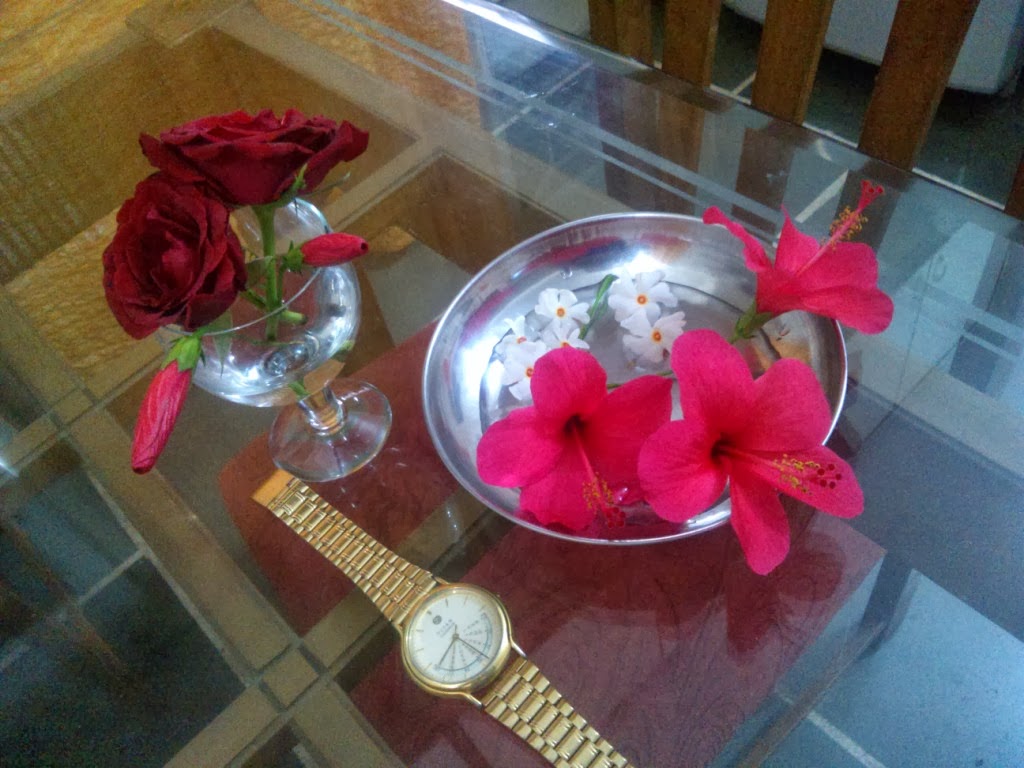 |
| 1. Hibiscus buds were tightly closed after being kept ovenight in the fridge |
The petals opened slowly and I monitored their progress through Day 1. The photographs have been taken in the afternoon, late evening and night.
 |
| 2. About one hour outside the fridge. |
 |
| 3. Afternoon of Day 1. Petals start opening |
 |
| 4. Evening of Day 1: Partially open buds |
At end of Day 1, the other flowers had closed and these remained in the partially open state.
The buds stayed in water overnight in the room.
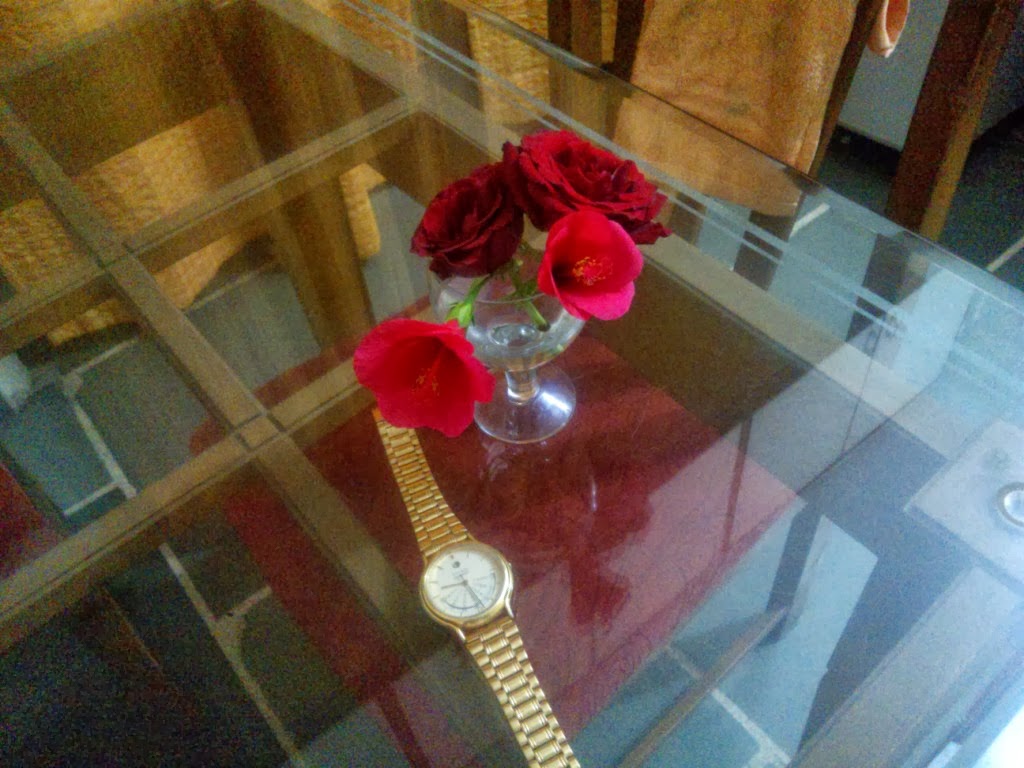 |
| 5. Night Day 1. Partially opened flowers. (9.29PM) |
Day 2: The buds bloomed fully and stayed open for the entire day. The petals shut tightly as the end ended.
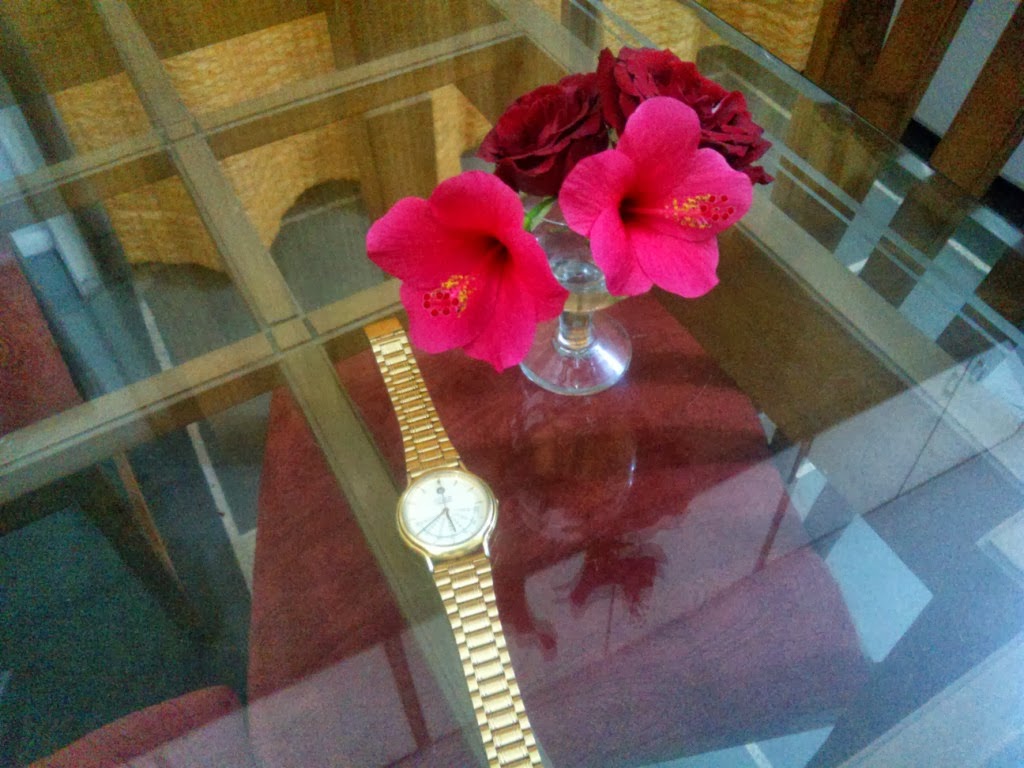 |
| 6. Fully open flowers (5.40AM) |
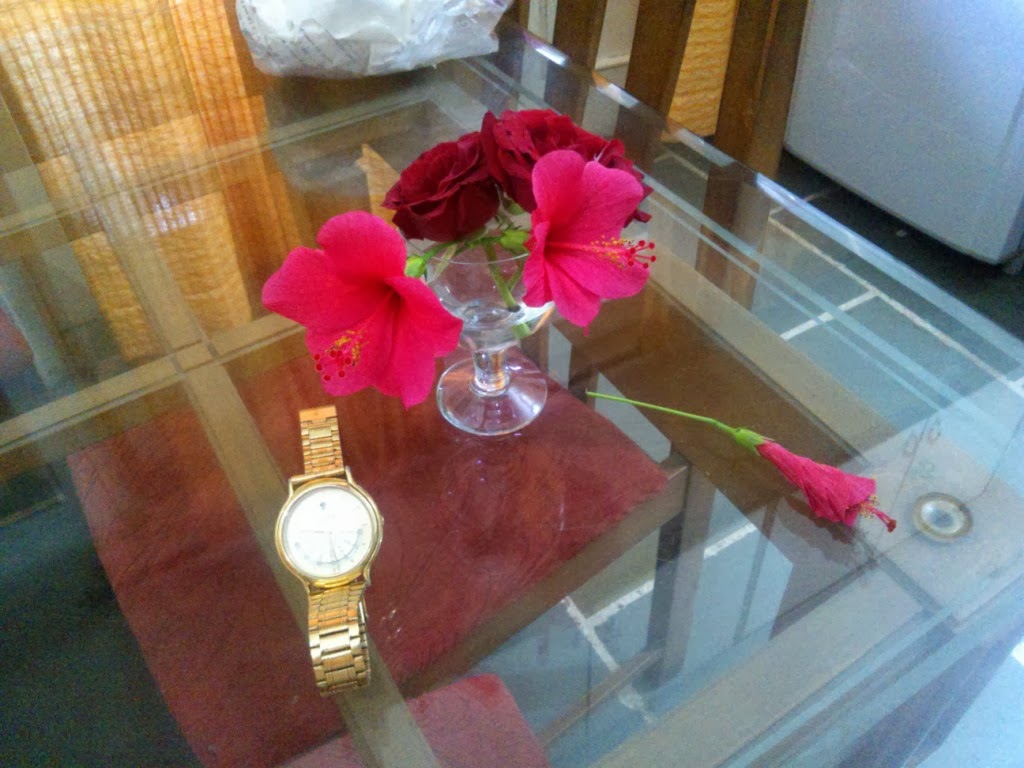 |
| 7. The flower of the previous day (Day 1) had closed. These flowers stayed fresh and fully open. (9.29AM) |
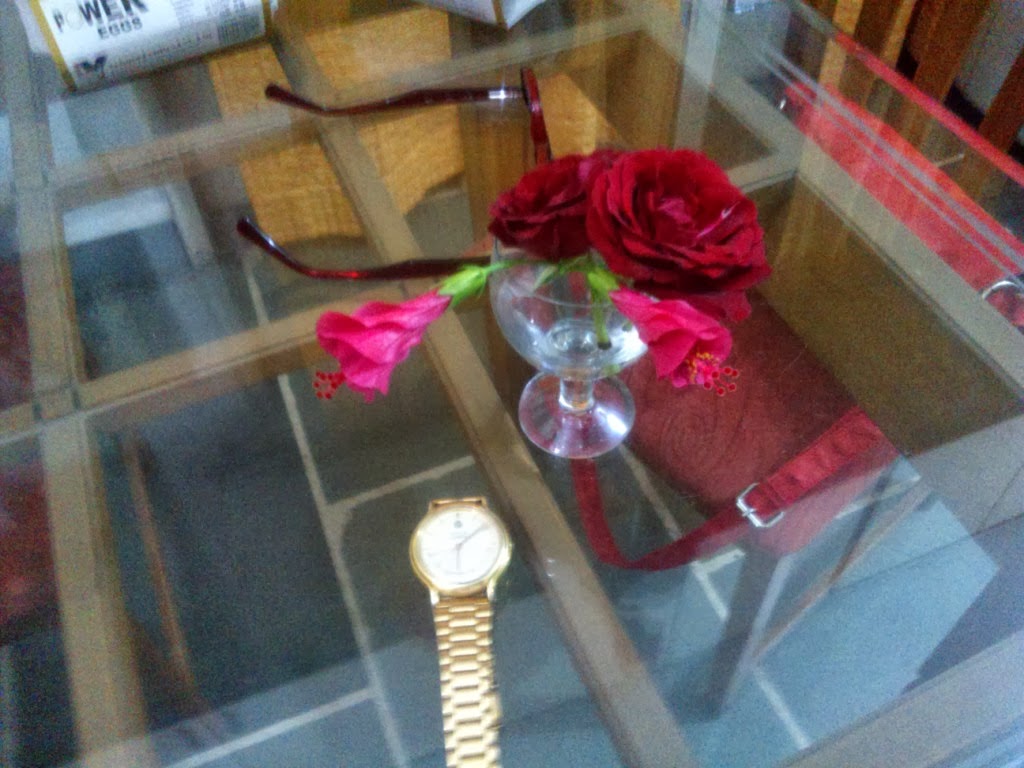 |
| 8. Petals close in the evening. (6.09PM) |
This seems to suggest that the flowers can be ‘tricked’ into blooming later. Their overnight stay in the dark refrigerator must have worked.
While writing this post, I came across this article that offers tips to keep Hibiscus flowers open.
I do not know if we can keep the buds in the fridge for another day
so that they can bloom on Day 3. If any of you tries this, do let us
know.
Take care!
Update (07 Oct 2013): Recently I have seen Hibiscus flowers for sale but this is very very rare. In the meantime you can try my experiment…
 |
| Hibiscus flowers are not always sold in the market. |
